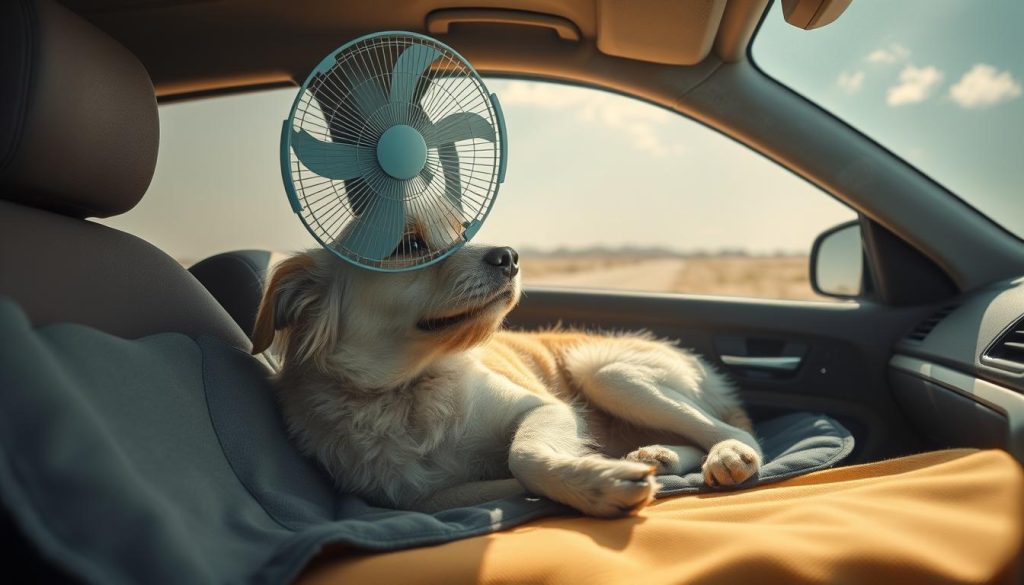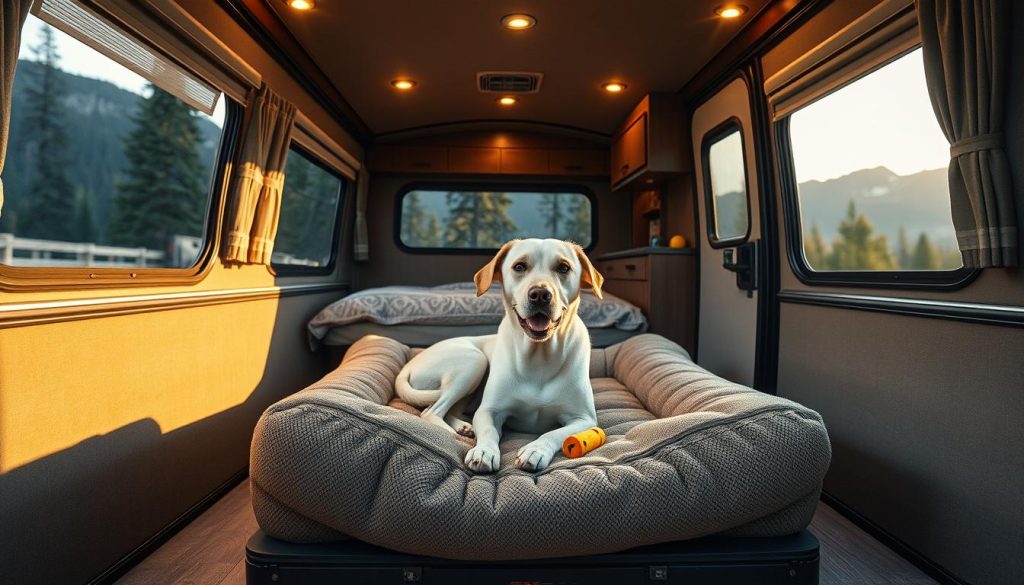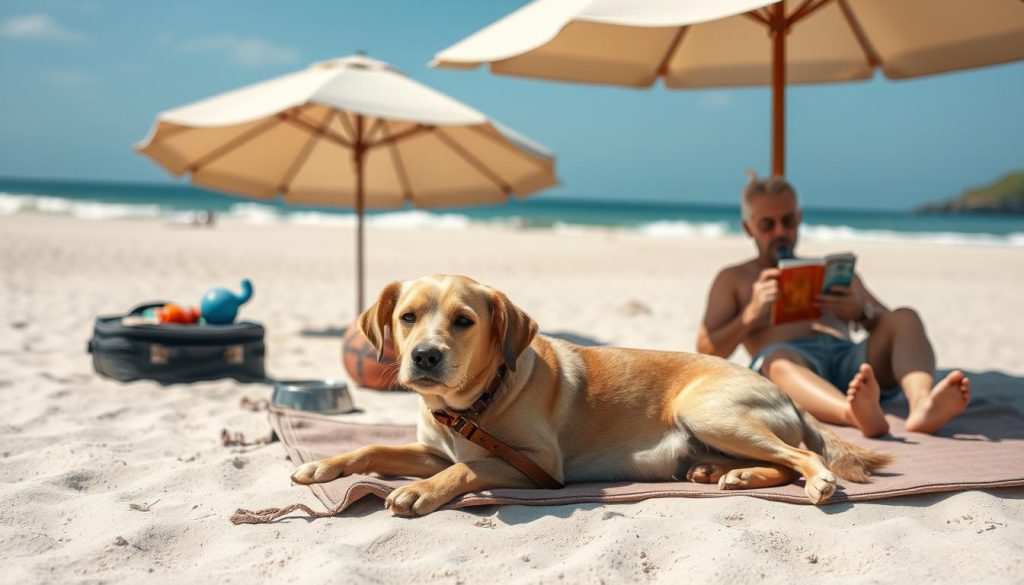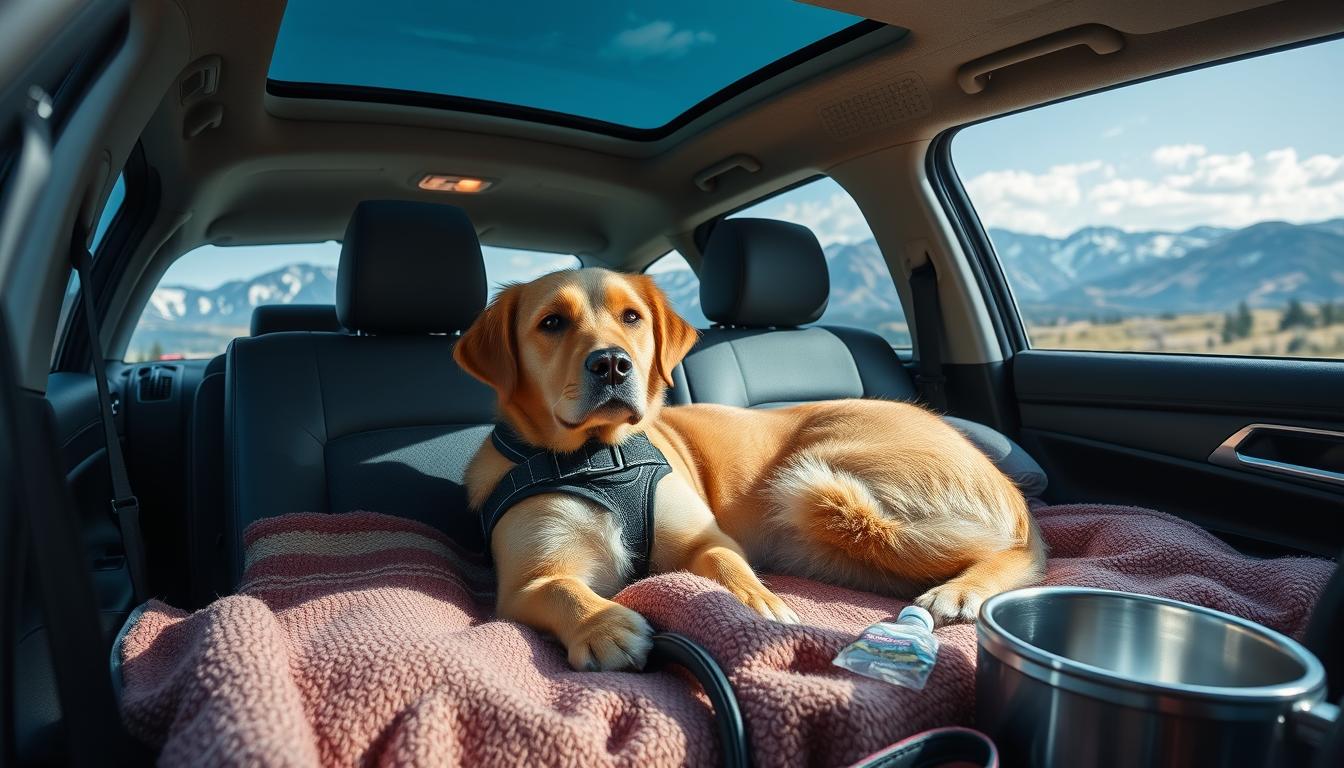Traveling with a senior dog can be both fun and a bit scary. Our older pets face special challenges on trips. It’s important to make sure they’re safe, happy, and comfortable. This article will give you tips for traveling with your older dog, from getting ready to go to handling emergencies.
Before you go, take your senior dog to the vet for a check-up. This makes sure they’re healthy enough for the trip. It’s also key to keep their medical records up-to-date. And don’t forget to pack everything they need to stay comfy and safe.
Traveling with older dogs has its challenges. I’ll talk about how to make them comfortable, like using soft bedding and keeping the car cool. If they have trouble moving, ramps and harnesses can help.
Older dogs might need special food and water, so I’ll cover that too. It’s also good to bring their favorite things and find pet-friendly places to stay. Keeping an eye on your dog’s health and safety is very important. I’ll give tips on spotting and handling any problems.
With the right care and planning, traveling with your senior dog can be great for both of you. This article will help you make sure your older dog is happy and comfortable on your trip. You’ll be able to make special memories together.
Preparing for the Journey
Before you start your trip with your senior dog, make sure they’re ready. First, book a detailed senior dog vet checkup. This talk lets you discuss any health issues and get a travel okay from your vet.
Also, get a copy of your dog’s medical records for travel. These records are key in case of an emergency on your trip.
Packing the Essentials
For packing your senior dog, think about these essential supplies for traveling with senior dogs:
- Soft, comfy bedding for their rest
- Items to keep them cool, like a cooling mat or coat
- A dog ramp or steps for easy getting in and out of the car
- Diapers and pads, just in case
- Plenty of fresh water and portable bowls
- Chew toys and long-lasting treats for fun
- Clothing or booties for paw and joint protection
By preparing and packing the right stuff, you make sure your senior dog’s trip is comfy and easy.
Ensuring Comfort During Travel

Traveling with senior dogs means making sure they’re comfy. Soft, supportive bedding can really help. It makes them relaxed and happy on the trip.
Soft Bedding and Temperature Control
Choose a comfy, orthopedic bed or mat for your senior dog. It helps cushion their joints and makes the trip better. Also, watch the car’s temperature closely. Older dogs feel extreme heat or cold more.
Keep the car at a good temperature. Don’t leave your dog alone in the car in the heat. This can cause heatstroke.
- Opt for soft, supportive bedding to cushion your senior dog’s joints
- Monitor the temperature in the vehicle and ensure it remains comfortable
- Never leave your senior dog unattended in the car, especially in hot weather
By keeping your senior dog comfy and controlling the car’s temperature, you make trips better for them.
Managing Mobility Issues
As our dogs get older, they might have trouble moving around. This can be due to arthritis or trouble getting in and out of the car. Luckily, there are ways to help senior dogs stay independent when traveling.
Ramps and Harnesses
Using a sturdy dog ramp is a great way to help your senior dog. These ramps are light and easy to carry. They make it safe for your older pet to get in and out of the car without getting hurt.
Also, a good harness can give your dog more support and stability. It helps during walks and when getting in and out of the car.
- Invest in a high-quality dog ramp to make it easier for your senior dog to access the car
- Use a secure harness to provide additional support and stability during mobility-related tasks
- Carefully measure your dog and choose a ramp and harness that are tailored to their size and needs
Adding these mobility aids to your senior dog’s travel plan makes sure they’re comfortable and safe. It also makes the trip better for both of you.
Catering to Age-Related Needs

As our dogs get older, they may need different food and comfort. When traveling with a senior dog, make sure to meet these needs for a smooth trip.
Diet and Hydration
Senior dogs may need different food than younger ones. Always pack their usual food to prevent stomach problems. Keeping their eating schedule the same and giving them lots of water is key, especially in hot weather or on long trips.
Make sure your senior dog drinks enough water on the road. Watch their water intake and give them breaks to drink. Think about bringing a portable water bowl or bottle for easy access to fresh water.
Comfort Items and Pet-Friendly Accommodations
Items like favorite toys or blankets can make your senior dog feel safe and calm. When finding places to stay, look for pet-friendly spots with easy access to the outdoors and ground-floor rooms.
By focusing on your senior dog’s food, water, and comfort, you can make their travel fun and relaxing.
Monitoring Health and Safety
When you take your senior dog on a trip, watch their health closely. Look for signs they might be uncomfortable, tired, or sick. Check their behavior, eating, and energy often. If you see anything strange, talk to a vet right away.
Keeping your senior dog safe and healthy while traveling is key. Here are some important things to watch and think about:
- Look for signs of dehydration, like dry gums or being very tired. Make sure they drink water often.
- Watch for signs of getting too hot or working too hard. Be ready to cool them down if they need it.
- Check how well your senior dog moves. Use ramps or harnesses if they have trouble getting in or out of the car.
- See if your senior dog is comfortable. Change their bedding or the temperature if they need it to stay cozy.
It’s also key to have a plan for emergencies. Find out where the nearest vet clinics are along your path and at your destination. This way, you’re ready for anything and can make sure your dog is safe and happy.
older dog travel tips

Traveling with a senior dog can be fun but needs extra care. As dogs get older, they have different needs. It’s important to plan well for their comfort and well-being on trips. By following some key tips, you can make the trip good and stress-free for your older dog.
First, talk to your vet before you go. They can tell you about your dog’s health, suggest medicines, and say it’s okay to travel. Make sure you have your dog’s medical records and any needed prescriptions ready.
- Pack soft bedding, a cozy blanket, and their favorite toys or treats for comfort during the trip.
- Think about getting ramps or harnesses for your senior dog to move easily in tight spots or get in and out of the car.
- Watch how much your dog drinks and eats to avoid stomach problems.
- Look for places that are pet-friendly and quiet for your dog to rest and relax.
Putting your senior dog’s comfort, health, and safety first makes for a great trip. With some planning and lots of love, you and your dog can go on new adventures and make happy memories together.
Stress Management and Relaxation
Traveling with senior dogs can be fun, but it can also stress them out. As they get older, they feel more upset by travel’s changes. To make your senior dog happy and calm, try calming products and solutions.
Calming Products and Anxiety Wraps
Pheromone sprays and diffusers can make your senior dog feel calm. They copy calming smells that dogs naturally make. Also, anxiety wraps or vests give gentle pressure that calms them down.
Start using these products before your trip so your dog gets used to them. This makes the trip easier and more comfortable for your pet.
Using calming products helps, but being calm yourself is key too. Stick to your dog’s usual routine as much as you can. This makes them feel safe and secure, cutting down on stress. It lets them enjoy the trip more.
Planning for Emergencies
If an emergency happens while my senior dog is traveling, I’ll be ready. I’ve found vet clinics along our path and at our destination. I also have my dog’s medical records and any needed prescriptions handy.
Being ready for surprises is key to acting fast in emergencies. I’m sure my planning will help keep my senior dog safe and sound on our trip.
Whether it’s a sudden illness or injury, I’m prepared. Having a plan means I can focus on my dog’s comfort and safety. With the right prep, we can face any challenge on our journey.

